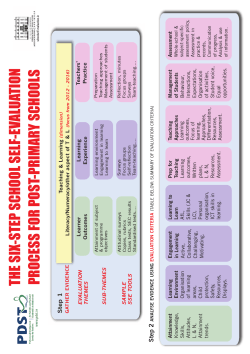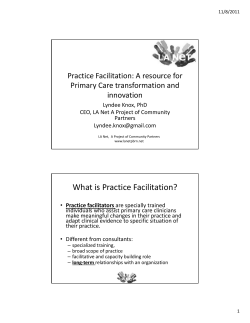
CG-CAHPS Patient Experience Survey
February 20, 2015 Christine Crofton, Ph.D. CAHPS Program Director Center for Quality Improvement and Patient Safety Agency for Healthcare Research and Quality 540 Gaither Road Rockville, MD 20850 RE: Notice of Proposed Changes for the Consumer Assessment of Healthcare Providers and Systems (CAHPS) Clinician and Group Survey, Federal Register Vol. 80, No. 13, January 21, 2015 Dear Dr. Crofton: On behalf of our nearly 5,000 member hospitals, health systems and other health care organizations, and our 43,000 individual members, the American Hospital Association (AHA) appreciates the opportunity to comment on the Agency for Healthcare Research and Quality’s (AHRQ) proposed changes to the Clinician and Group Consumer Assessment of Healthcare Providers and Systems (CG-CAHPS) patient experience survey. The proposed changes also address the Patient-Centered Medical Home (PCMH) item set, which is used in combination with CG-CAHPS to create the CAHPS PCMH Survey. AHRQ proposes several changes to reduce patient and provider burden, yet retain important information, promote consistency across CAHPS surveys and maintain the reliability of CAHPS measures. Specifically, AHRQ would move several “core” CG-CAHPS and PCMH item set questions to its list of “supplemental” questions. The resulting core CG-CAHPS survey would be reduced from 34 to 31 questions, and the core PCMH set would be reduced from 18 to six questions. AHRQ also proposes to change the reference time period for each survey question from “in the last 12 months” to “in the last six months.” This change would make the core CGCAHPS consistent with the version of the survey being implemented by the Centers for Medicare & Medicaid Services (CMS) in its Physician Quality Reporting System (PQRS) program. The AHA applauds AHRQ’s proposal to shorten the CG-CAHPS survey and the PCMH item set, and agrees these changes would reduce patient and provider burden. However, we urge the agency to take additional steps to reduce burden further by supporting the Christine Crofton, Ph.D. February 20, 2015 Page 2 of 3 development of lower-cost survey administration options. In addition, we ask the agency to explain and provide more analysis to support its proposal to use a six-month instead of a 12-month timeframe for survey questions. We provide more detail on each of these recommendations below. REDUCING SURVEY BURDEN The AHA supports AHRQ’s proposal to reduce the number of survey questions, and believes this reduction is an important first step toward a more effective survey tool. The AHA has long favored the use of patient experience surveys as tools to help providers improve the engagement and satisfaction of patients and their families. However, the proliferation of questions on such surveys has resulted not only in substantial costs to providers to collect the data, but also a significant burden to patients. Indeed, many patients have expressed frustration to our members about the length of surveys and the amount of time it takes to complete them. It is critical that surveys include a parsimonious set of questions so that valuable patient time and finite provider resources are used efficiently and effectively. However, we urge AHRQ to reduce survey burden further by supporting the development of lower-cost survey administration approaches – such as emailed or web-based surveys. The use of more economical survey approaches is especially important because patients now may receive multiple surveys from the CAHPS “family,” including surveys for hospitals, nursing homes, dialysis facilities and home health agencies. While we appreciate the value of assessing the patient experience across the care continuum, the use of multiple surveys means more time spent by patients to answer surveys, and more resources expended by providers to administer them. Moreover, for the purposes of CMS reporting programs using CAHPS tools, providers are permitted to use only two survey administration modes – mailed surveys and telephone surveys. Mailed surveys are relatively inexpensive to administer, but often suffer from low response rates and a significant time lag. Telephonic surveys typically yield a higher response rate and provide more timely results, but are much more expensive to administer. We strongly encourage AHRQ to work with the CAHPS consortium to develop guidelines for emailed and web-based surveys for the entire CAHPS family. Once this guidance is developed, AHRQ also should encourage CMS to permit the use of emailed and web-based surveys in CMS reporting programs. To date, AHRQ has provided very limited guidance on appropriate procedures for using electronic survey methodologies. Yet, electronic survey administration modes, such as email and web-based portals, make survey data collection and aggregation timelier and less expensive, and may allow hospitals to increase sample size without greatly increasing cost. In developing guidance for emailed and web-based surveys, AHRQ also should engage with hospitals and other providers that have been using emailed and web-based surveys to collect data on patient experience informally. Christine Crofton, Ph.D. February 20, 2015 Page 3 of 3 SURVEY TIMEFRAME The AHA asks AHRQ to explain and make its analysis publicly available to support its proposal to use a six-month timeframe instead of a 12-month timeframe for survey questions. Our members enthusiastically support efforts to align and streamline federal quality measurement efforts, and we appreciate that AHRQ wishes to foster alignment with CMS reporting programs. However, we do not feel we have sufficient information at this time to lend our support to this proposal. In the Federal Register notice, AHRQ notes that “a study that randomized patients to a 12-month or 6-month survey version yielded similar CAHPS scores at the practice site level.” However, AHRQ does not share the detailed methodology and results of the study. These details are important because the use of a shorter survey timeframe would likely impact the reliability of survey data for some practices. In particular, smaller practices may find it difficult to obtain a statistically sound sample of responses. If AHRQ is intent on making a six-month timeframe the standard for the survey, we also encourage the agency to work with CMS to ensure its survey administration practices are aligned with this approach. For the purposes of PQRS, CMS attributes patients to a physician group based on whether that group provides the plurality of primary care services to the patient during an entire calendar year. CMS then randomly selects a sample of each practice’s attributed patients to whom survey vendors administer the survey. This approach appears to be inconsistent with the use of a six-month survey timeframe. Thank you for the opportunity to comment, and we look forward to continuing to work with you to improve the CAHPS surveys. If you have questions, please contact me or Akin Demehin, AHA senior associate director for policy, at (202) 626-2365 or ademehin@aha.org. Sincerely, /s/ Linda E. Fishman Senior Vice President Public Policy Analysis and Development
© Copyright 2025









